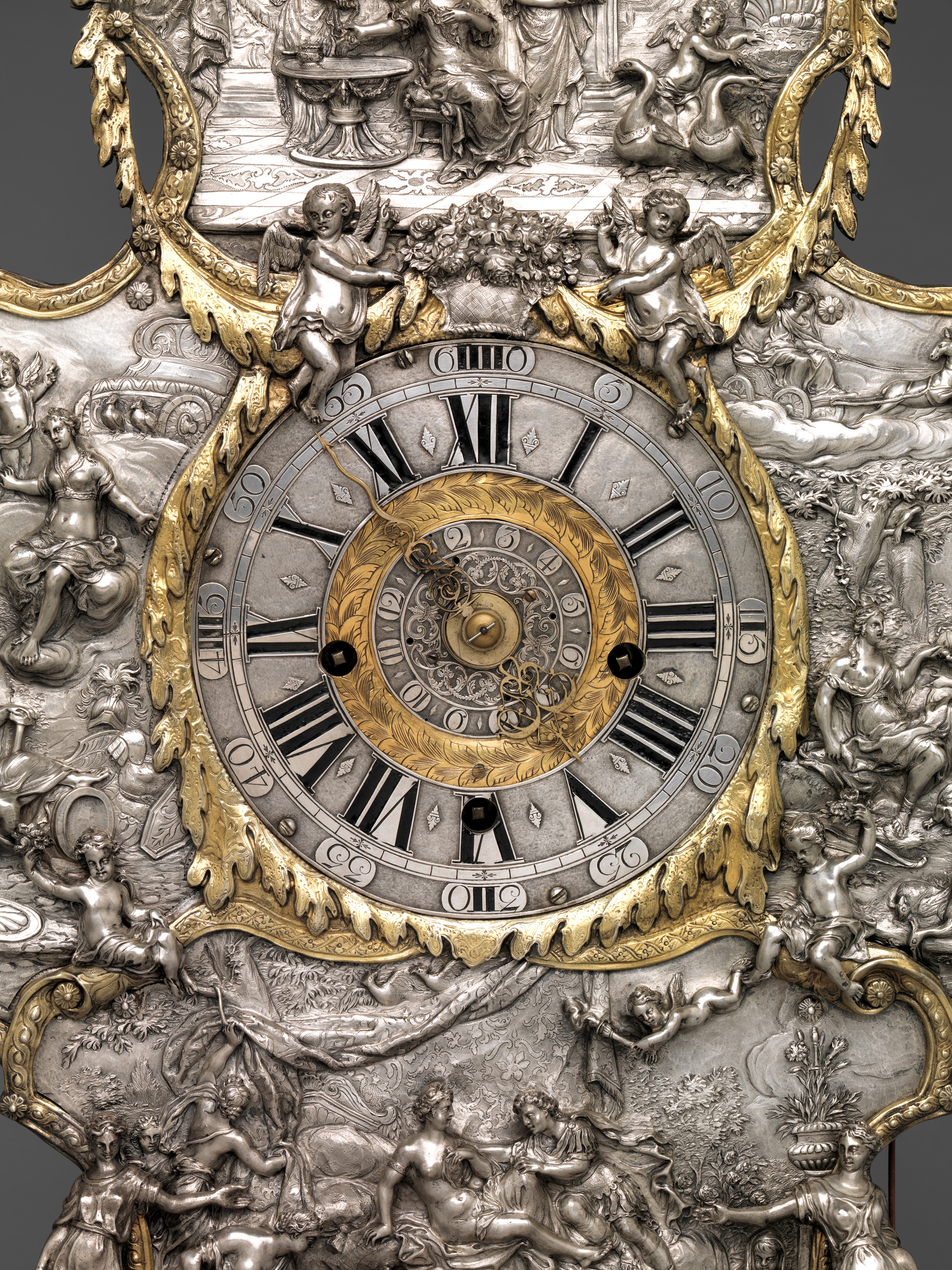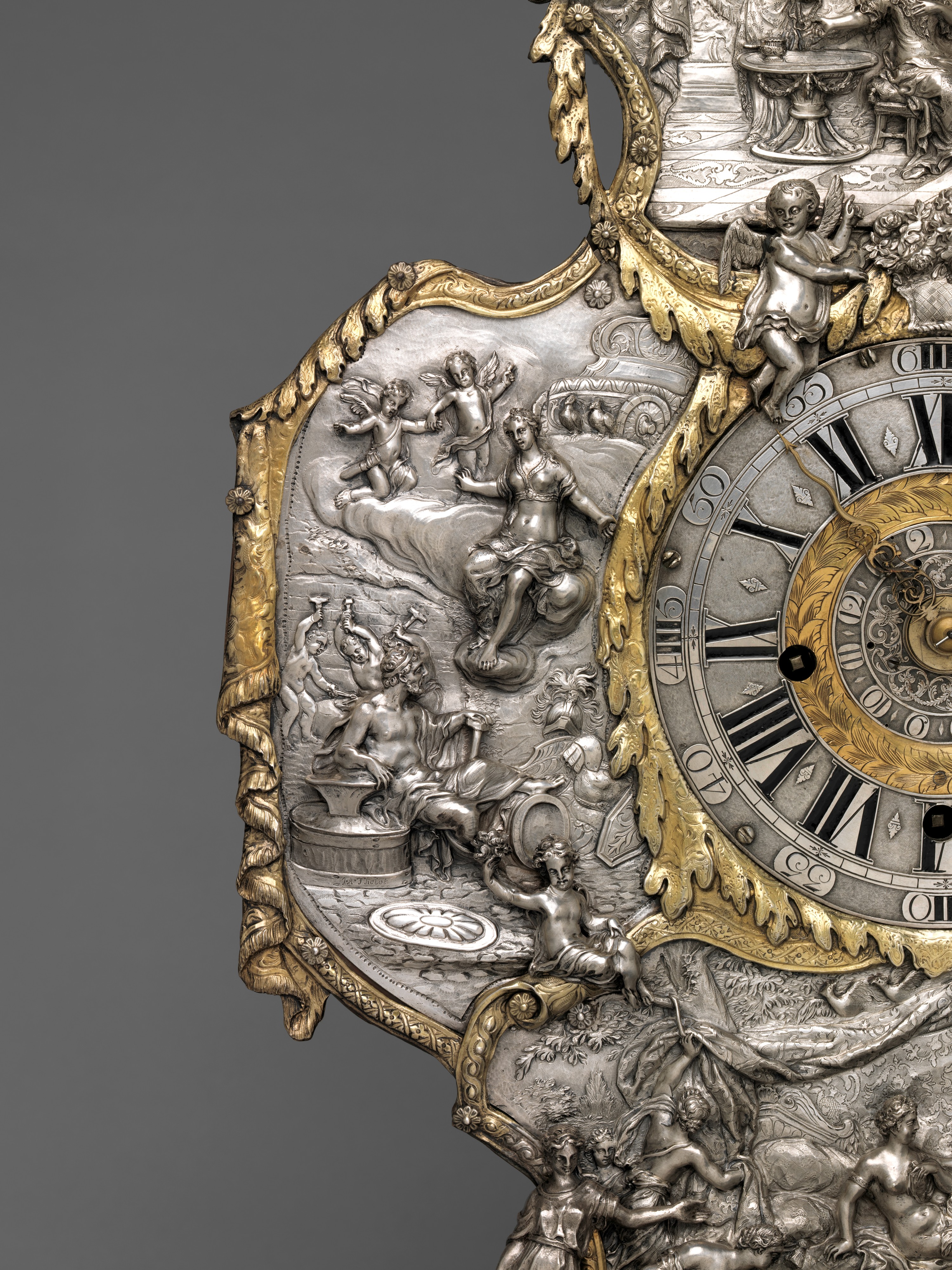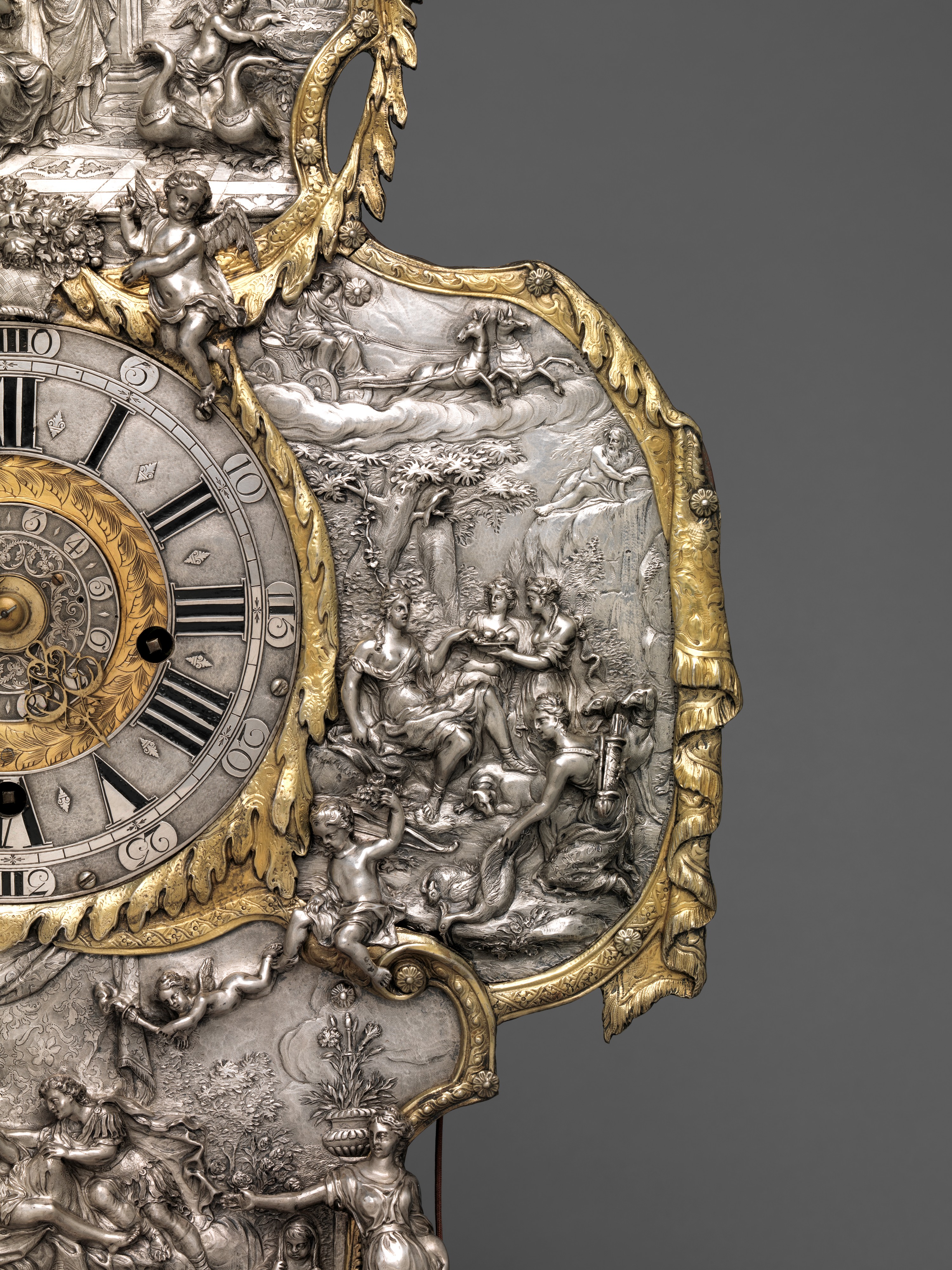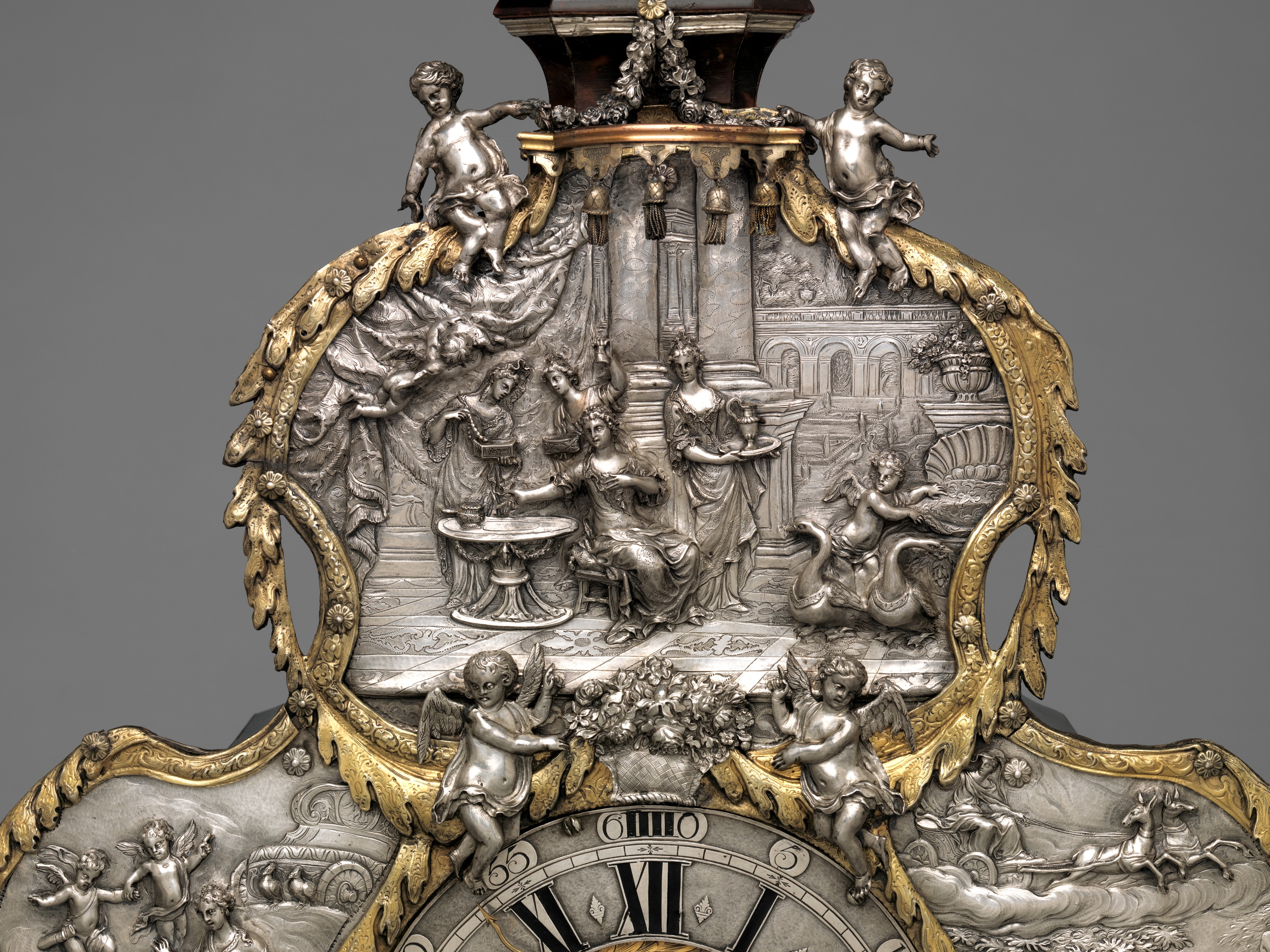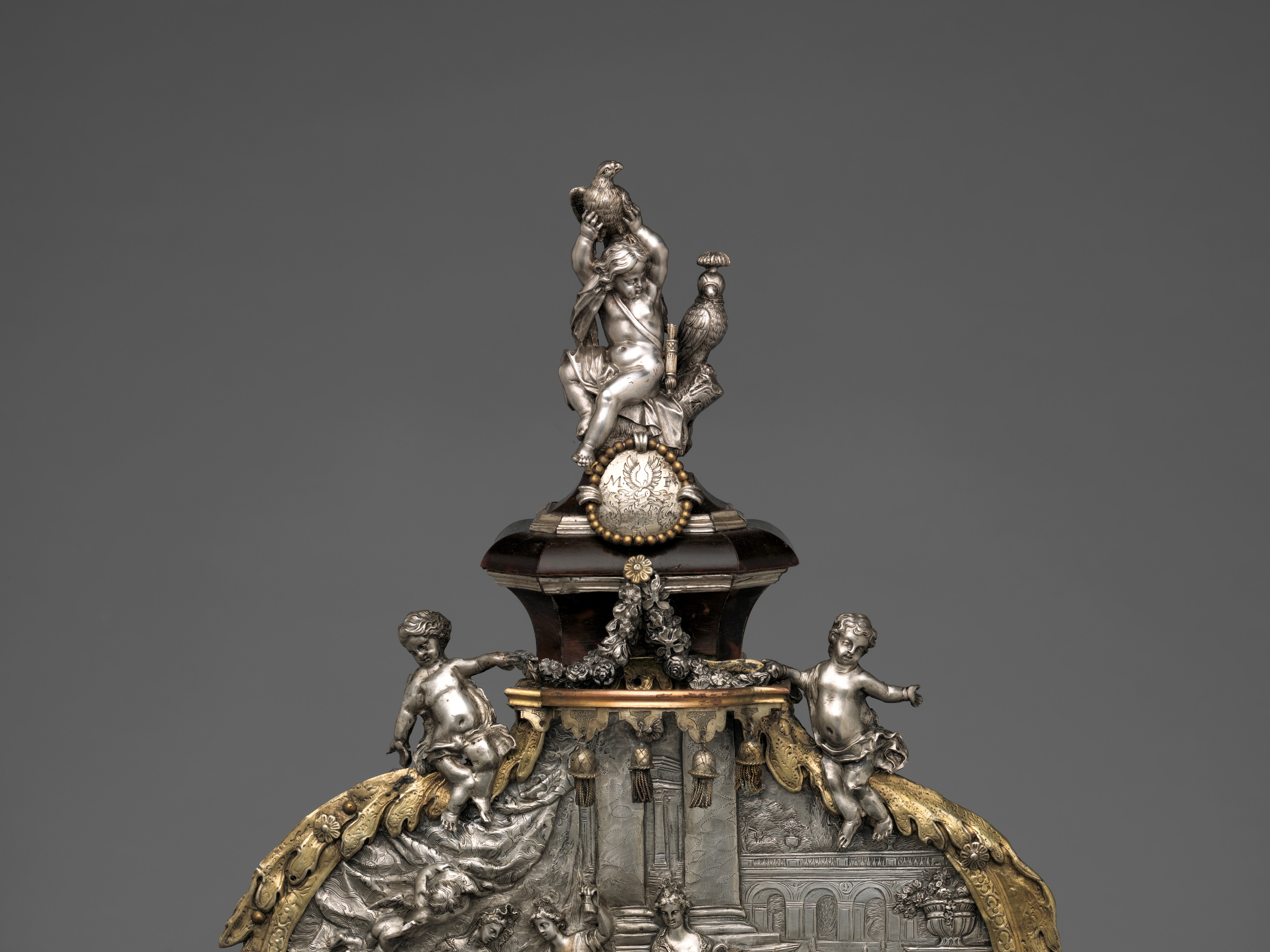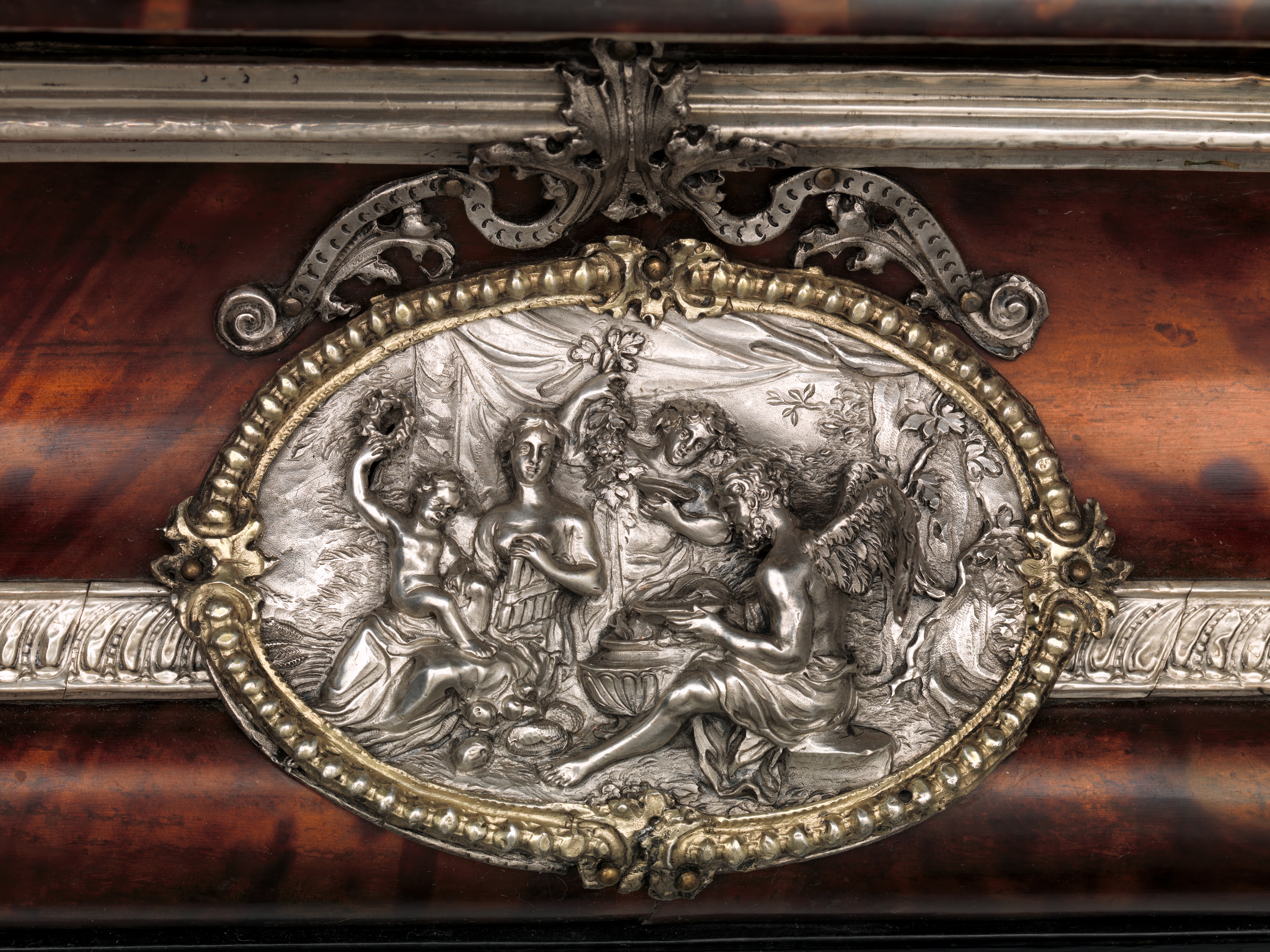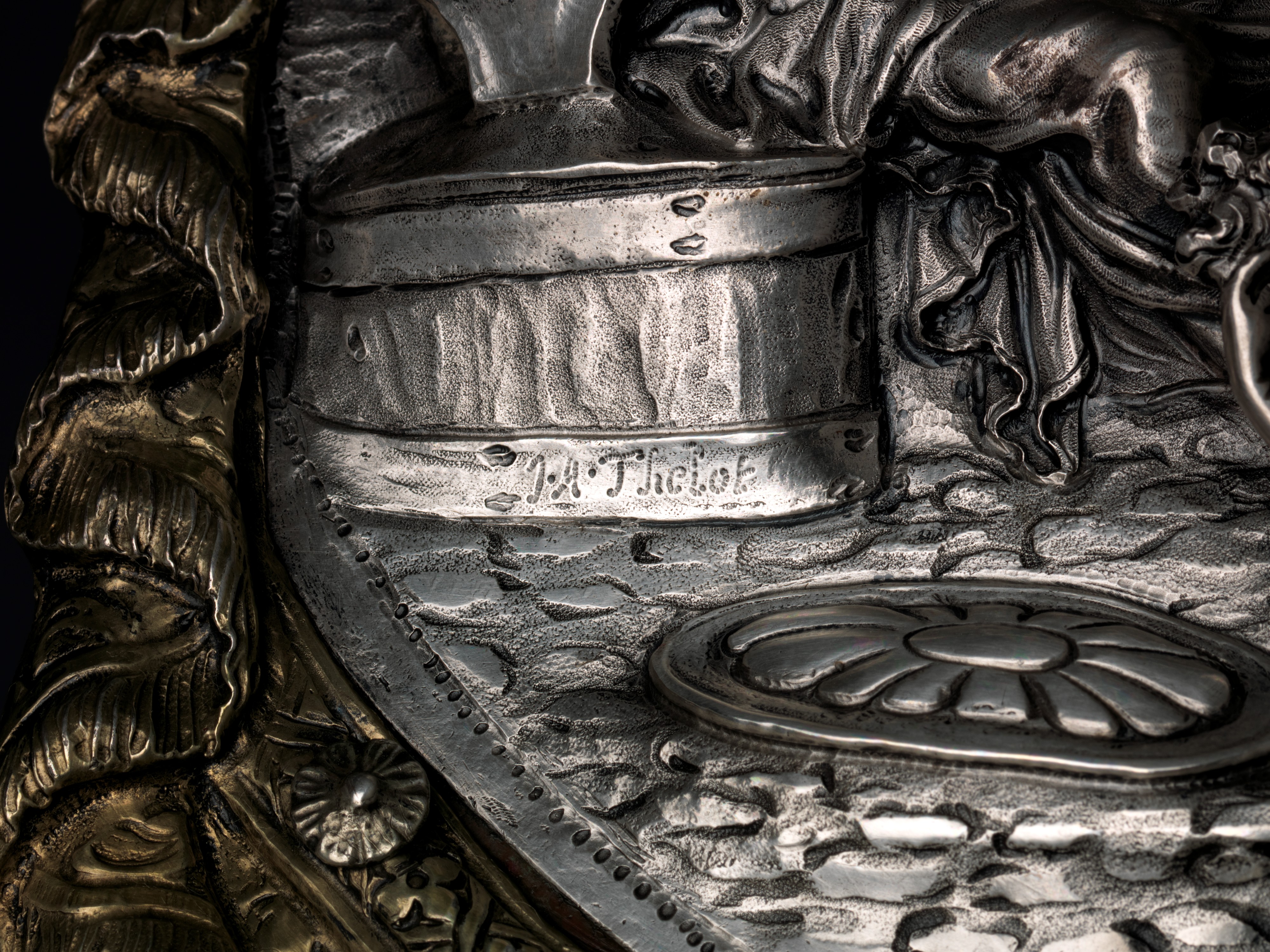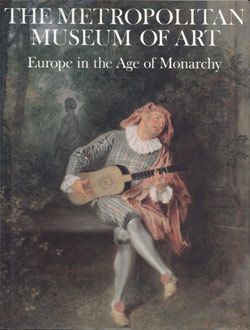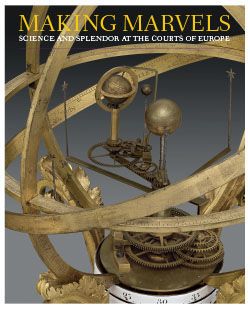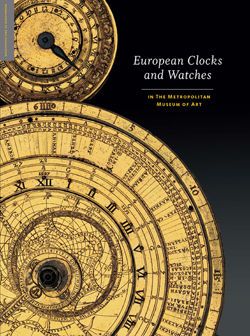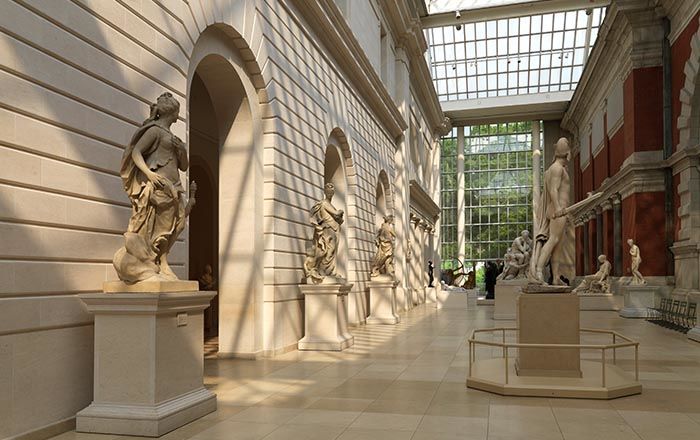Mantel clock with alarm
Clockmaker: Franz Xavier Gegenreiner German
Case maker: Johann Andreas Thelot German
Some clocks are valued as much for their ornamental cases as they are for their time-telling properties. One of the few clocks acquired by the Metropolitan Museum by purchase rather than as a gift falls securely into the category of decorative masterpieces. Its case displays five silver reliefs by an Augsburg goldsmith, Johann Andreas Thelot (or Thelott; 1655–1734), who is considered by many to be the best artist of his time in this medium.
Augsburg, his city, was severely afflicted by an outbreak of the plague in 1628. In 1632, the plague was followed by a siege of the forces of King Gustavus Adolphus (1594–1632) of Sweden during the Thirty Years’ War (1618–48), which brought catastrophe to much of Germany. By the end of the war, Augsburg had lost more than half of its inhabitants. So great was the reputation and the commercial acumen of the city’s goldsmiths, however, that when hostilities ceased, the export trade in ornamental silver plate recovered its vitality, and by the end of the century there were more goldsmiths at work in Augsburg than there had been before the outbreak of the war.[1] In the last quarter of the century, Augsburg goldsmiths specialized in mounting painted enamels, semiprecious stones, and gemstones on gilded silver or gold to create remarkable objects of baroque exuberance.[2] Side by side with this production there continued to exist an older tradition of working with silver in high relief, or repoussé, to create decorative or narrative scenes.
Thelot, who worked in the traditional technique,[3] came from a French Huguenot family that emigrated from Dijon in 1585. The son of Israel Thelot (1616–1696), a master in the Augsburg guild of goldsmiths, Johann made many of his early works in collaboration with his father. The first relief signed with his own name is dated 1679, but he did not become a master goldsmith in Augsburg for another ten years, time he spent partly in Italy.[4] More than 130 of his works are now known, nearly all of them finely detailed scenes worked in extraordinarily high relief, and many adopted from engravings and paintings by such well-known artists as Jacques Callot (1592–1635), Nicolas Poussin (1594–1665), and Charles LeBrun (1619–1690).[5] The original designs for the four vignettes illustrating mythological legends of the goddesses Venus and Diana that appear on the Metropolitan’s clock, however, have never been identified. Perhaps they were original to the goldsmith. A fifth, smaller plaquette, with an allegorical scene attached to the base of the clock, is also surely the work of Thelot. The four figures in the scene, probably representing The Seasons, include (from left to right) a bouncing infant holding a wreath aloft; a seated female with pan pipes under her arm and a selection of fruit and vegetables beside her; a youthful Bacchus holding a bunch of grapes and a wine cup; and an old man in the guise of Chronos warming a dish over a brazier.[6]
The four larger silver scenes, framed by curtains and foliate swags of gilded silver, surround the dial of the clock. They merit close attention as part of a group, two of which are signed by the goldsmith. Starting from the top, they illustrate Venus, or Aphrodite as the Greeks knew her, in a setting of classical architectural elements. She is seated at a round table near her swan-drawn chariot that is guarded by Cupid. Three of her handmaidens are bringing her the necessities of her toilette. Above the scene, two infants perch precariously at the top, and below it two winged putti present a basket filled with flowers. Moving clockwise, the next scene is most probably devoted to the goddess Diana (Artemis to the Greeks). She drives a chariot pulled by two female deer, and below a bank of clouds she appears again, seated in a wooded glen with a waterfall in the background. Accompanied by her hunting hounds, one snuggled at her feet, she is offered a dish of produce by two of her nymphs and a brace of game birds by a third. While she has formerly been identified as Venus,[7] she more closely resembles Diana, a deity who presides over game and hunting and whose habitat is the natural world. In addition, her long hair with loose-hanging curls, her Cretan hunting shoes, and her dress, caught up high on the waist but leaving one breast bare, mark her as Diana rather than Venus, goddess of love.
At the lower left of the Diana scene, still another infant, this one seated on the frame of the next scene, points to the dial of the clock. Below, in another stage-like setting, a curtain is pulled back to reveal Mars in a baroque version of Roman military dress and the nearly nude Venus reclining on a bed and attended by handmaidens and infants in various animated poses. One of them is kneeling at the bottom right and molesting a pair of birds nesting in the upturned helmet of Mars above the incised signature, “J. A. Thelot.” On either side of the scene, standing female figures gesture toward the amorous pair. On the upper left still another infant calls attention to the last scene, where Vulcan greets his cloud-borne consort, Venus, who has alighted from her chariot, this time drawn by doves and accompanied by an animated infant Cupid leading a fellow cherub by the hand. On the stake supporting Vulcan’s anvil is the incised signature “J. A. Thelot.”
The center of all this activity, but no less impressive, is the champlevé silver dial with a chapter ring of hours (I–XII), the numerals filled with black wax, and a chapter ring of minutes (5–60, by fives, the quarters marked I–IIII). The half hours are further indicated by lozenges, and the individual minutes by incised lines. In the center there is a dial for setting the alarm (1–12). Openwork, scrolled brass hour and minute hands indicate the time.
As Klaus Maurice has demonstrated, the form of this part of the clock (the dial and the four plaquettes) descends from a variety of German wall clock, or plate clock (Telleruhr),[8] so called because the early examples resembled dinner plates. But here, supported by a hexagonal base with six bun feet, the silver “plate” is bolted to one of brass that is mounted on a wooden structure and veneered with tortoiseshell, and it has thin silver moldings typical of furniture made in Augsburg in the late seventeenth and early eighteenth centuries. The front of the base displays the repoussé silver allegorical scene in a frame with a baroque-scrolled crest; the back contains a drawer for the winding key; and the structure below serves as a container for the movement, as well as support for the silver plaquettes. At the top of the structure, an infant hunter releases a falcon, while a hooded falcon rests alongside him. Below the cherub with the falcon appears an oval plaque that displays the coat of arms for an unidentified owner, which is probably a later addition.
If the case of the clock reflects the height of baroque design in Augsburg, the present movement suggests that the turn of the eighteenth century was a less illustrious moment in the history of Augsburg’s clockmaking. For during the course of the Thirty Years’ War, the city that in the sixteenth century had been one of the chief suppliers of domestic clocks to all of Europe fell seriously behind other clockmaking centers. Unlike the goldsmiths and jewelers, the clockmakers never really recovered enough to regain their former status. Their reluctance to adopt the new technology can be demonstrated by the history of the reception in Augsburg of its native, Johann Philipp Treffler (1625–1698). As reconstructed by the American historian Silvio Bedini,[9] Treffler had been an active mechanician and clockmaker at the court of the Medici Granduke of Tuscany, Ferdinando II (1610–1670) in Florence, where experimentation with pendulums by Galileo Galilei (1564–1642) and his son Vincenzio (died 1649)[10] was recent, and where Italian pendulum clocks were being made independently of Huygens’s invention by Galileo’s pupil Vincenzo Viviani (1622– 1703),[11] the brothers Giuseppe Campani (1635– 1715), better known for his optical instruments, especially the telescope,[12] and Pietro Tomasso Campani (active 1655–after 1683),[13] and Treffler. In 1664 Treffler returned to Augsburg, only to be denied membership in the powerful guild of clockmakers and forbidden by them from making or even selling watches and clocks in Augsburg.[14]
The rectangular-plated spring-driven movement contained within the case of the Museum’s clock is signed on the back plate: “Franz Xaveri Gegenreiner / Augsburg.” It has a short pendulum and is quarter striking as well as quarter repeating on two bells attached to the back of the case. The movement fits the requirements dictated by the dial, and it is the work of a competent but comparatively unknown clockmaker, identified by Maurice in the records of the clockmakers’ guild (Schmiedzunftbuch) in Augsburg.[15] He is listed as a maker of clocks (Grossuhrmacher) from Dölz in Bavaria on August 1, 1760, [16] and it is noted that he gained the right to make clocks in Augsburg by marrying the widow of one of the master clockmakers in the guild. Therefore, he would not have had the authority before 1760 to sign the Museum’s clock in the way that he did. The dial of the clock is without doubt closer in style to 1700 than to 1760, and as the movement fits the dial precisely, the movement must have been made explicitly for this extraordinary clockcase.
Now missing from the case are two birds that were photographed before 1912 atop the scene of Venus and Vulcan and the scene of Diana. The arms of the infant on the left of the top plaque have been awkwardly repaired, and to judge from the illustration of the clock in the 1912 catalogue for the collection of Baroness James de Rothschild,[17] the standing female figure on the left side of the scene of Venus and Mars is a twentieth-century replacement. It differs from the others in that it is cast. Also, in 1912 there were only three tassels hanging from the lambrequin at the top of the Toilette of Venus plaquette; there are now four, and there is provision for a fifth, presumably long lost. The thumbs of several of the figures in relief are missing, the moldings around the base of the clock are chipped and dented, and a wing of a figure in the relief on the base was repaired at some time before 1912. Tortoiseshell veneer has been replaced and renewed in various places, particularly on the back of the clock. The ebonized board at the base and the feet are later replacements. The minute hand was broken and repaired.
Each of the four silver plaquettes is stamped with the French weavil mark for gold and silver that was imported between 1836 and 1864, but the identity of the French owner is unknown. The clock was in the London collection of Baroness James de Rothschild by 1912, and later sold by J. and S. Goldschmidt of Frankfurt am Main and London.[18] It was listed among the possessions of William Randolph Hearst by 1941, [19] and it appeared in a New York auction of property from private collections in 1946, at which time it was purchased by the Museum.[20]
Notes (For key to shortened references see bibliography in Vincent and Leopold, European Clocks and Watches in the Metropolitan Museum of Art. NY: The Metropolitan Museum of Art, 2015)
[1] Muller 1968; Seling 1994, p. 27.
[2] See entry 16 in this volume for a watchcase exemplifying the style.
[3] Recent authors have spelled his name Thelott, but signatures on his silver plaquettes are spelled Thelot.
[4] Prael-Himmer 1978, p. 18; Schommers 1994, p. xxvi.
[5] See, for example, Prael-Himmer 1978, pp. 41, 51, 53.
[6] The author would like to thank Ellenor M. Alcorn, Curator, Department of European Sculpture and Decorative Arts, Metropolitan Museum, for suggesting the meaning of this unusual representation.
[7] Jones 1912, p. 118; Prael-Himmer 1978, p. 88.
[8] Maurice 1976, vol. 2, p. 91, nos. 750–60, and figs. 750–60.
[9] Bedini 1956–57. See also Maurice 1976, vol. 1, pp. 182–84, 186. For some clocks by Treffler, see Maurice 1976, vol. 2, p. 85, nos. 679–81, and figs. 679–81.
[10] Brusa 1978, pp. 115–16; Vehmeyer 2004, vol. 1, pp. 218–19, 222–23.
[11] Vehmeyer 2004, vol. 2, pp. 942–43.
[12] For two of Giuseppe Campani’s telescopes, both in the Museo Galileo in Florence (inv. nos. 2556 and 3185), see Righini Bonelli 1968, p. 188, no. 424, and pl. 94 (bottom), and p. 189, no. 447. See also Encyclopedia of Astronomers 2014, pp. 357–58.
[13] For one of his silent night clocks, now in the British Museum, London (inv. no. CAI-2128), see Thompson 2004, pp. 72–73. See also Stephanie Walker in Baroque Palaces of Rome 1999, pp. 196–98, no. 62, for more about the Campani family’s work in Rome and a bibliography about the family.
[14] Bedini 1956–57, p. 422.
[15] Maurice 1976, vol. 1, p. 298.
[16] Probably the spa Bad Tolz, south of Munich in Bavaria. See Abeler 1977, pp. 205–6, who gives a confusing account of the clocks attributed to this maker.
[17] Jones 1912, pl. lx.
[18] Ibid., p. 118 and pl. lx.
[19] See Hearst Collection 1941, p. 307 (no. 1164-3).
[20 See Parke-Bernet Galleries 1946, p. 30, no. 102, ill. p. 31.
This image cannot be enlarged, viewed at full screen, or downloaded.
This artwork is meant to be viewed from right to left. Scroll left to view more.


